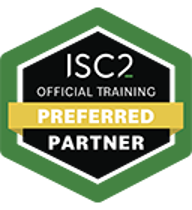ISC2 Systems Security Certified Practitioner
From £2,693 + VAT was £4,075
Book online today or, if you need help choosing the right course or would like to discuss business discounts, call us on 0113 220 7150.
Overview
The official (ISC)2 Systems Security Certified Practitioner (SSCP) is the ideal certification for those with proven technical skills and practical, hands-on security knowledge in operational IT roles. It provides confirmation of a practitioner’s ability to implement, monitor and administer IT infrastructure in accordance with information security policies and procedures that ensure data confidentiality, integrity and availability. This course includes, the official courseware and SSCP exam voucher and is taught by an accredited official (ISC)2 trainer.
The broad spectrum of topics included in the SSCP Common Body of Knowledge (CBK) ensure its relevancy across all disciplines in the field of information security.
Successful candidates are competent in the following 7 domains:
1. Access Controls
2. Security Operations and Administration
3. Risk Identification, Monitoring, and Analysis
4. Incident Response and Recovery
5. Cryptography
6. Network and Communications Security
7. Systems and Application Security
Prerequisites
Candidates must have a minimum of 1-year cumulative work experience in 1 or more of the 7 domains of the SSCP CBK. A 1-year prerequisite pathway will be granted for candidates who received a degree (bachelors or masters) in a cybersecurity program.
A candidate that doesn’t have the required experience to become an SSCP may become an Associate of (ISC)² by successfully passing the SSCP examination. The Associate of (ISC)² will then have 2 years to earn the 1 year required experience. You can learn more about SSCP experience requirements and how to account for part-time work and internships at www.isc2.org/Certifications/SSCP/experiencerequirements.
Outline
Domain 1: Access Controls
1.1 Implement and maintain authentication methods
-
Single/multifactor authentication
-
Single sign-on » Device authentication
-
Federated access
1.2 Support internetwork trust architectures
-
Trust relationships (e.g., 1-way, 2-way, transitive)
-
Extranet
-
Third party connections
1.3 Participate in the identity management lifecycle
-
Authorization » Proofing
-
Provisioning/de-provisioning
-
Maintenance » Entitlement
-
Identity and Access Management (IAM) systems
1.4 Implement access controls
-
Mandatory
-
Non-discretionary
-
Discretionary
-
Role-based
-
Attribute-based
-
Subject-based
-
Object-based
Domain 2: Security Operations and Administration
2.1 Comply with codes of ethics
-
(ISC)² Code of Ethics
-
Organizational code of ethics
2.2 Understand security concepts
-
Confidentiality
-
Integrity
-
Availability
-
Accountability
-
Privacy
-
Non-repudiation
-
Least privilege
-
Separation of duties
2.3 Document, implement, and maintain functional security controls
-
Deterrent controls
-
Preventative controls
-
Detective controls
-
Corrective controls
-
Compensating controls
2.4 Participate in asset management
-
Lifecycle (hardware, software, and data)
-
Hardware inventory
-
Software inventory and licensing
-
Data storage
2.5 Implement security controls and assess compliance
-
Technical controls (e.g., session timeout, password aging)
-
Physical controls (e.g., mantrap, cameras, locks)
-
Administrative controls (e.g., security policies and standards, procedures, baselines)
-
Periodic audit and review
Domain 3: Risk Identification, Monitoring, and Analysis
3.1 Understand the risk management process
-
Risk visibility and reporting (e.g., risk register, sharing threat intelligence, Common Vulnerability Scoring System (CVSS))
-
Risk management concepts (e.g., impact assessments, threat modelling, Business Impact Analysis (BIA))
-
Risk management frameworks (e.g., ISO, NIST)
-
Risk treatment (e.g., accept, transfer, mitigate, avoid, recast)
3.2 Perform security assessment activities
-
Participate in security testing » Interpretation and reporting of scanning and testing results » Remediation validation
-
Audit finding remediation 3.3 Operate and maintain monitoring systems (e.g., continuous monitoring)
-
Events of interest (e.g., anomalies, intrusions, unauthorized changes, compliance monitoring)
-
Logging » Source systems
-
Legal and regulatory concerns (e.g., jurisdiction, limitations, privacy)
3.4 Analyse monitoring results
-
Security baselines and anomalies
-
Visualizations, metrics, and trends (e.g., dashboards, timelines)
-
Event data analysis
-
Document and communicate findings (e.g., escalation)
Domain 4: Incident Response and Recovery
4.1 Support incident lifecycle
-
Preparation
-
Detection, analysis, and escalation
-
Containment » Eradication
-
Recovery
-
Lessons learned/implementation of new countermeasure
4.2 Understand and support forensic investigations
-
Legal and ethical principles
-
Evidence handling (e.g., first responder, triage, chain of custody, preservation of scene)
4.3 Understand and support Business Continuity Plan (BCP) and Disaster Recovery Plan (DRP) activities
-
Emergency response plans and procedures (e.g., information system contingency plan)
-
Interim or alternate processing strategies
-
Restoration planning
-
Backup and redundancy implementation
-
Testing and drills
Domain 5: Cryptography
5.1 Understand fundamental concepts of cryptography
-
Hashing » Salting
-
Symmetric/asymmetric encryption/Elliptic Curve Cryptography (ECC)
-
Non-repudiation (e.g., digital signatures/ certificates, HMAC, audit trail)
-
Encryption algorithms (e.g., AES, RSA)
-
Key strength (e.g., 256, 512, 1024, 2048 bit keys)
-
Cryptographic attacks, cryptanalysis, and counter measures
5.2 Understand reasons and requirements for cryptography
5.3 Understand and support secure protocols
5.4 Understand Public Key Infrastructure (PKI) systems
-
Fundamental key management concepts (e.g., key rotation, key composition, key creation, exchange, revocation, escrow)
-
Web of Trust (WOT) (e.g., PGP, GPG)
-
Hashing
-
Salting
-
Symmetric/asymmetric encryption/Elliptic Curve Cryptography (ECC)
-
Non-repudiation (e.g., digital signatures/ certificates, HMAC, audit trail)
-
Encryption algorithms (e.g., AES, RSA)
-
Key strength (e.g., 256, 512, 1024, 2048 bit keys)
-
Cryptographic attacks, cryptanalysis, and counter measures
-
Confidentiality
-
Integrity and authenticity
-
Data sensitivity (e.g., PII, intellectual property, PHI)
-
Regulatory
-
Services and protocols (e.g., IPSec, TLS, S/MIME, DKIM)
-
Common use cases » Limitations and vulnerabilities
6: Network and Communications Security
6.1 Understand and apply fundamental concepts of networking
-
OSI and TCP/IP models » Network topographies (e.g., ring, star, bus, mesh, tree)
-
Network relationships (e.g., peer to peer, client server)
-
Transmission media types (e.g., fiber, wired, wireless)
-
Commonly used ports and protocols
6.2 Understand network attacks and countermeasures (e.g., DDoS, man-in-the-middle, DNS poisoning)
6.3 Manage network access controls
-
Network access control and monitoring (e.g., remediation, quarantine, admission)
-
Network access control standards and protocols (e.g., IEEE 802.1X, Radius, TACACS)
-
Remote access operation and configuration (e.g., thin client, SSL VPN, IPSec VPN, telework)
6.4 Manage network security
-
Logical and physical placement of network devices (e.g., inline, passive)
-
Segmentation (e.g., physical/logical, data/control plane, VLAN, ACLs)
-
Secure device management
6.5 Operate and configure network-based security devices
-
Firewalls and proxies (e.g., filtering methods) » Network intrusion detection/prevention systems
-
Routers and switches » Traffic-shaping devices (e.g., WAN optimization, load balancing)
6.6 Operate and configure wireless technologies (e.g., bluetooth, NFC, WiFi)
-
Transmission security
-
Wireless security devices (e.g.,WIPS, WIDS)
Domain 7: Systems and Application Security
7.1 Identify and analyze malicious code and activity
-
Malware (e.g., rootkits, spyware, scareware, ransomware, trojans, virus, worms, trapdoors, backdoors, and remote access trojans)
-
Malicious code countermeasures (e.g., scanners, anti-malware, code signing, sandboxing)
-
Malicious activity (e.g., insider threat, data theft, DDoS, botnet)
-
Malicious activity countermeasures (e.g., user awareness, system hardening, patching, sandboxing, isolation)
7.2 Implement and operate endpoint device security
-
HIDS
-
Host-based firewalls
-
Application white listing
-
Endpoint encryption
-
Trusted Platform Module (TPM)
-
Mobile Device Management (MDM) (e.g., COPE, BYOD)
-
Secure browsing (e.g., sandbox)
7.3 Operate and configure cloud security
-
Deployment models (e.g., public, private, hybrid, community)
-
Service models (e.g., IaaS, PaaS and SaaS)
-
Virtualization (e.g., hypervisor) » Legal and regulatory concerns (e.g., privacy, surveillance, data ownership, jurisdiction, eDiscovery)
-
Data storage and transmission (e.g., archiving, recovery, resilience)
-
Third party/outsourcing requirements (e.g., SLA, data portability, data destruction, auditing) » Shared responsibility model
7.4 Operate and secure virtual environments
-
Software-defined networking
-
Hypervisor
-
Virtual appliances
-
Continuity and resilience
-
Attacks and countermeasures
-
Shared storage
Supplementary References
Candidates are encouraged to supplement their education and experience by reviewing relevant resources that pertain to the CBK and identifying areas of
study that may need additional attention. View the full list of supplementary references at www.isc2.org/certifications/References.
Examination Policies and Procedures
QA will provide the delegate with an SSCP exam voucher to be taken post course. (ISC)² recommends that SSCP candidates review exam policies and procedures prior to registering for the examination. Read the comprehensive breakdown of this important information at www.isc2.org/Register-for-Exam.

We are an (ISC)2 accredited CPE submitter.

QA is proud to be an (ISC)2 Official Training Partner.
Learn more about our ISC2 certification training.

QA is an approved training provider for ELCAS, proud to support service leavers in their transition into the tech industry. Learn more about Elcas approved training here.
Why choose QA
- Award-winning training, top NPS scores
- Nearly 300,000 learners in 2020
- Our training experts are industry leaders
- Read more about QA
Special Notices
This is an official (ISC)2 Course and exam, delegates can earn CPE Credits.
Or (ISC)2 members can submit CPE credits directly to the CPE portal in the Members section of the (ISC)2 website.
To see all our ISC2 courses, please click here.
Cyber Security learning paths
Want to boost your career in cyber security? Click on the roles below to see QA's learning pathways, specially designed to give you the skills to succeed.
Cyber Defensive Operations learning paths
Want to boost your career in Cyber Defensive Operations? View QA's learning pathways below, specially designed to give you the skills to succeed.

Frequently asked questions
How can I create an account on myQA.com?
There are a number of ways to create an account. If you are a self-funder, simply select the "Create account" option on the login page.
If you have been booked onto a course by your company, you will receive a confirmation email. From this email, select "Sign into myQA" and you will be taken to the "Create account" page. Complete all of the details and select "Create account".
If you have the booking number you can also go here and select the "I have a booking number" option. Enter the booking reference and your surname. If the details match, you will be taken to the "Create account" page from where you can enter your details and confirm your account.
Find more answers to frequently asked questions in our FAQs: Bookings & Cancellations page.
How do QA’s virtual classroom courses work?
Our virtual classroom courses allow you to access award-winning classroom training, without leaving your home or office. Our learning professionals are specially trained on how to interact with remote attendees and our remote labs ensure all participants can take part in hands-on exercises wherever they are.
We use the WebEx video conferencing platform by Cisco. Before you book, check that you meet the WebEx system requirements and run a test meeting (more details in the link below) to ensure the software is compatible with your firewall settings. If it doesn’t work, try adjusting your settings or contact your IT department about permitting the website.
How do QA’s online courses work?
QA online courses, also commonly known as distance learning courses or elearning courses, take the form of interactive software designed for individual learning, but you will also have access to full support from our subject-matter experts for the duration of your course. When you book a QA online learning course you will receive immediate access to it through our e-learning platform and you can start to learn straight away, from any compatible device. Access to the online learning platform is valid for one year from the booking date.
All courses are built around case studies and presented in an engaging format, which includes storytelling elements, video, audio and humour. Every case study is supported by sample documents and a collection of Knowledge Nuggets that provide more in-depth detail on the wider processes.
When will I receive my joining instructions?
Joining instructions for QA courses are sent two weeks prior to the course start date, or immediately if the booking is confirmed within this timeframe. For course bookings made via QA but delivered by a third-party supplier, joining instructions are sent to attendees prior to the training course, but timescales vary depending on each supplier’s terms. Read more FAQs.
When will I receive my certificate?
Certificates of Achievement are issued at the end the course, either as a hard copy or via email. Read more here.
Let's talk
A member of the team will contact you within 4 working hours after submitting the form.
